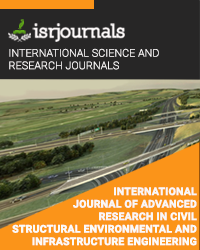strength behavior of self-curing fly ash concrete using steel fiber
R. Aarthi,R. Venkatakrishnaiah
Published in International Journal of Advanced Research in Civil,Structural,Environmental and Infrastructure Engineering and Developing
ISSN: 2320-723X Impact Factor:1.7 Volume:2 Issue:1 Year: 08 May,2014 Pages:1-7

Abstract
Curing is the process of controlling the rate and extent of moisture loss from concrete during cement hydration. It may be either after it has been placed in position or during the manufacture of concrete products. Good curing is not practically possible in most of the cases. The self-curing concrete means that no external curing required for concrete. Self-curing provides an internal water reservoir throughout the concrete, so that it is more readily available to maintain saturation of the cement paste during hydration, avoiding self-desiccation (in the paste) and reducing autogenous shrinkage. The grade of concrete selected was M30. Self-curing is done by Super Absorbent Polymer (SAP). The effect of variation in strength properties were studied for different dosage of self-curing agent (0.1% – 0.5% weight of cement) steel fiber (1%, 1.5%, 2%) and compared with fly ash concrete. By compression test optimum percentage of SAP is found as 0.3 and steel fiber is 1.5.
Kewords
Curing, Self-Curing, Concrete, Self-curing Agent.
Reference
[1] R. Venkatakrishanaiah and Dr G. Mohankumar (2013). Experimental study on strength of high volume high calcium fly ash concrete , IOSR Journal of mechanical and civil engineering (ISSN :2278-1684), 5(4): 48-54. [2] R. Venkatakrishanaiah and Dr G. Mohankumar (2013). Mechanical and Durability Properties of HVHC Fly ash concrete, European Journal of Scientific Research (ISSN 1450-216X/ 1450-202X) 96(4):582-590. [3] M.Manoj Kumar and D.Maruthachalam (2013), Experimental Investigation on Self-curing Concrete, Issue 3 volume 2, March-April 2013 ISSN 2249-9954. [4] Alvaro Paul and Mauricio Lopez (2011), ‘Assessing Lightweight Aggregate Efficiency for Maximizing Internal Curing Performance’, ACI Materials Journal, volume 108. [5] Ambily.P.S and Raja mane N.P, (2009), ‘Self-Curing Concrete – An Introduction’, Concrete Composites Lab, Structural Engineering Research Centre, Chennai. [6] Bart Craeye, Matthew Geirnaerta and Geert De Schutter, (2011), ‘Super absorbing polymers as an internal curing agent for mitigation of early-age cracking of high-performance concrete bridge decks’ Construction and Building Materials 25, 1–13. [7] Bentz. D.P, (2007), ‘Internal curing of high-performance blended cement mortars’, ACI materials Journal 104 (4) (July–August 2007) 408–414. [8] Bentz .D.P and Lura.P, (2005) J.W. Roberts, ‘Mixture proportioning for internal curing’ Concrete International Paper, pp.1–6. [9] Dale P. Bentz, (2007), ’Internal Curing of High-Performance Blended Cement Mortars’ ACI Materials Journal, Vol 104. [10] Daniel Cusson, and Ted Hoogeveen, (2008), “Internal curing of high-performance concrete with pre-soaked fine light weight aggregate for prevention of autogenous shrinkage cracking”, Cement and Concrete Research 38. [11] El-Dieb. A.S, (2006), self – curing concrete: Water retention, hydration and moisture transport. Construction and Building Materials, 21, 1282 – 1287.

